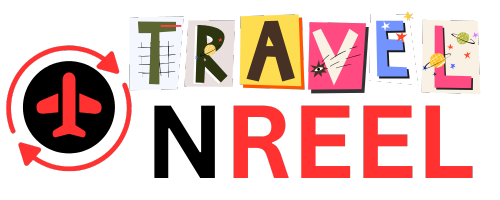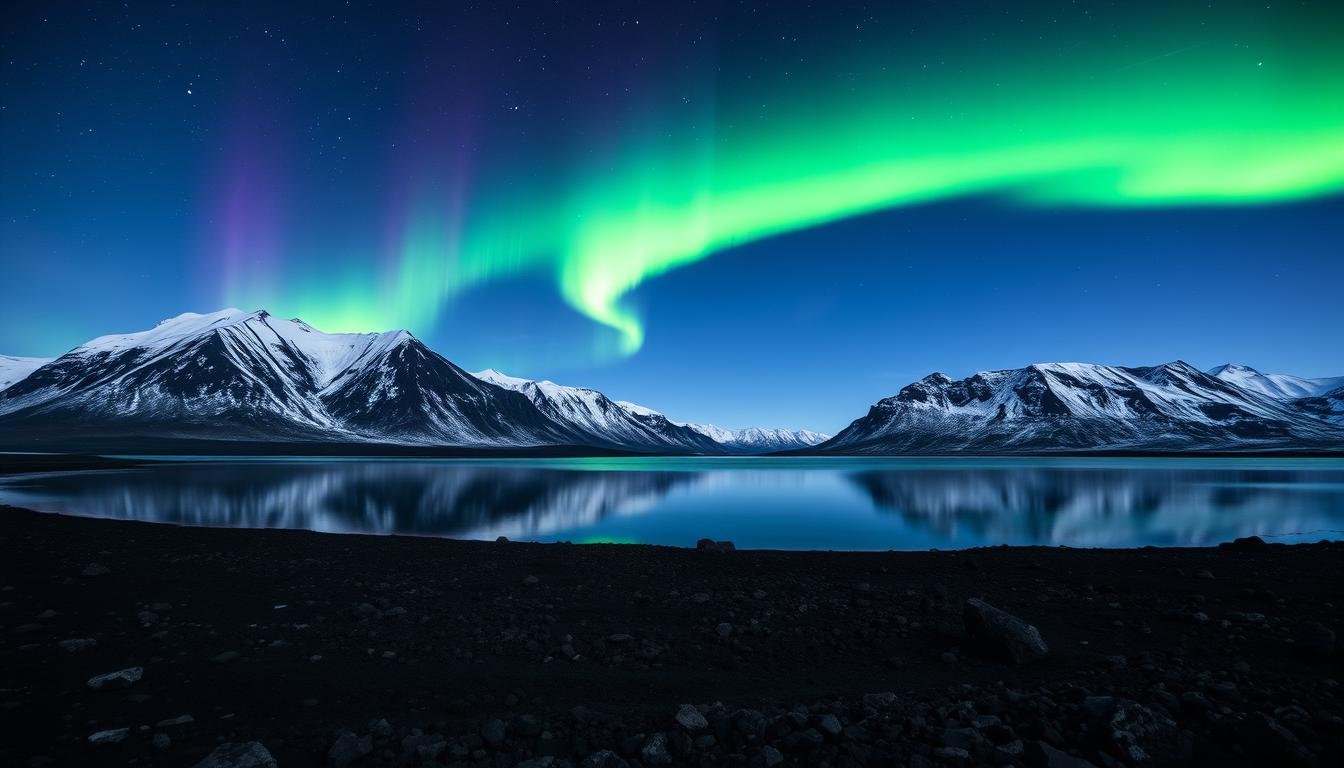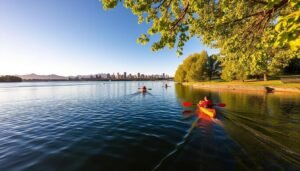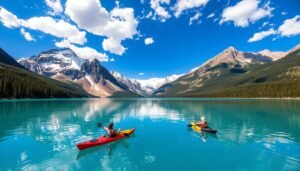The Northern Lights, or Aurora Borealis, are a breathtaking sight. Many dream of seeing them, especially in Iceland. They can be seen from September to April, when nights are dark.
Imagine seeing greens, purples, and reds dance in the sky. It’s a sight unlike any other.
To see the northern lights in Iceland, you need to plan. Places like Jokulsarlon glacier lagoon and North Iceland, especially Akureyri, are magical. Going on Iceland northern lights tours can help you see this wonder.
In this guide, we’ll explore the science behind the Northern Lights. We’ll also talk about best place and time to see northern lights in Iceland.
Key Takeaways
- The ideal viewing season for the Northern Lights in Iceland runs from September to April.
- Maximum darkness occurs during the winter months, particularly around the winter solstice.
- Guided tours can greatly increase your chances of seeing the Aurora Borealis.
- Key locations include Jokulsarlon, Akureyri, and areas accessible from Reykjavik.
- Optimal viewing conditions often correlate with clear, dark skies.
Table of Contents
What Are the Northern Lights?
The northern lights are a breathtaking natural wonder that draws many travelers each year. They are known for their stunning colors, mainly green, with purple, red, and blue appearing under certain conditions. This colorful display in the sky is thanks to the science of aurora borealis. It happens when solar particles hit Earth’s magnetic field, making the atmosphere glow.
The Science Behind the Aurora Borealis
The aurora borealis is caused by solar storms that send particles into space. When these particles reach Earth, they meet the magnetic field, creating beautiful lights. In Iceland, the best time to see the northern lights is during the dark nights. Places far from cities are best for seeing this amazing sight.
Cultural Impact and Folklore
The cultural significance of northern lights varies across cultures. Many ancient people saw them as sacred, with their own myths and stories. For example, the Sami people and Norse mythology have tales about the northern lights. Icelandic culture, however, has fewer stories about auroras, showing a unique view of this wonder.
When is the Best Time to See the Northern Lights in Iceland?
The Iceland northern lights season is from late September to early April. This is a great time for those wanting to see this amazing sight. The long nights and good weather make it more likely to see the lights.
January is a top month for seeing the Northern Lights in Iceland. It has up to 20 hours of darkness, especially in the Westfjords and Akureyri. February also has long nights, perfect for viewing in places like the Snaefellsnes Peninsula and Lake Mývatn.
March is another good month. The nights are still dark, making it easy to see the lights. Places like the Golden Circle and Thingvellir National Park are great spots. As April comes, the chances to see the lights stay high, especially in the Eastfjords and Vik.
Traveling in November to February is the best for seeing the Northern Lights. December has the longest nights, making it even better in areas with little light pollution.
May to July are not good for seeing the lights because of the Midnight Sun. But, August and September are better again. The nights get dark, and September has great displays because of the equinox. To increase your chances, check local forecasts.
| Month | Likelihood of Seeing Northern Lights | Recommended Locations |
|---|---|---|
| January | High | Westfjords, Akureyri |
| February | High | Snaefellsnes Peninsula, Lake Mývatn |
| March | High | Golden Circle, Thingvellir National Park |
| April | High | Eastfjords, Vik |
| August | High | Varied Locations |
| September | High | Varied Locations |
| December | High | Westfjords, Snaefellsnes Peninsula |
How to See the Northern Lights in Iceland
Seeing the Northern Lights in Iceland is magical. I can choose from guided tours or self-driving. Each option makes my experience unforgettable.
Different Viewing Methods
There are many ways to see the Northern Lights. These include:
- Guided tours: Guided tours are great. They take me to the best spots based on the weather. Tours can be by bus or super jeep.
- Self-driving: Renting a car lets me explore freely. I can find quiet spots away from city lights. Places like Thingvellir National Park are perfect.
- Boat tours: Boat tours offer a unique view. They let me see the auroras from the water.
Guided Tours and Self-Driving Options
Choosing between guided tours and self-driving depends on what I like. Guided tours are easy to fit into any trip. Here’s more about each:
| Feature | Guided Tours | Self-Driving |
|---|---|---|
| Convenience | Experts handle the details, no driving worries. | I can explore at my own pace. |
| Access | Visit places cars can’t reach. | Go to my favorite spots without crowds. |
| Cost | Includes transport and sometimes photography lessons. | More affordable with friends. |
| Experience | Can include hot springs and more. | See other sights on the ring road. |
In summary, whether I choose guided tours or self-driving, both offer great chances to see the Northern Lights. With the right prep and clear skies, my trip will be unforgettable.
Best Place and Time to See Northern Lights in Iceland
To see the northern lights in Iceland, you need to know the best spots and times. The location, season, and weather all affect how well you can see them. Iceland has many beautiful places that are great for watching the lights.
Optimal Locations in Iceland
Iceland’s landscapes are perfect for seeing the northern lights. Some top places include:
- Thingvellir National Park – This UNESCO site has dark skies and amazing views.
- Jökulsárlón Glacier Lagoon – The water makes the lights look even more stunning.
- Fjallsárlón Glacier Lagoon – It’s less busy than Jökulsárlón and has clear skies.
- Rural Camping Areas – These spots are far from city lights, making it easier to see the aurora.
Seasonality and Viewing Conditions
The northern lights are best seen from September to April. December and January have the longest nights, giving you more time to see them. The sky is darker and clearer in winter, making it easier to spot the lights.
Weather is important for seeing the lights. The best time is between 10 PM and 12 AM when it’s dark. Check the weather forecast for aurora activity and cloud cover. Being patient and flexible can help you see the lights.
Staying for at least seven nights can increase your chances of seeing the lights. They often appear in cycles of 2-3 nights followed by a quiet period. Get ready to enjoy Iceland’s beauty and watch the northern lights.
Northern Lights in North Iceland
North Iceland is a great place to see the northern lights. It has many spots known for amazing views of the aurora borealis. The area has little light pollution and the right geography for seeing this natural wonder.
Key Locations for Viewing
In North Iceland, some places are better than others for seeing the lights:
- Akureyri: The biggest town, Akureyri, has easy access to dark skies for watching the aurora.
- Húsavík: This coastal town is far away, making it a great spot for seeing the lights.
- Ásbyrgi Canyon: In Vatnajökull National Park, this canyon has low light levels for better aurora views.
Local Tour Options
Joining a guided tour in North Iceland can help you see the northern lights. There are many local tours available, including:
- Late-night sightseeing trips: These trips take you away from city lights for better views.
- Boat tours: See the auroras from the water for a unique view.
- Countryside stays: Stay in rural places made for watching the auroras.
Northern Lights in South Iceland

South Iceland is a beautiful place to see the northern lights. The natural beauty and the lights make every moment special. Visitors can see the lights in many amazing spots, surrounded by Iceland’s stunning landscapes.
Best Scenic Spots for Sightings
For those wanting to see the northern lights in South Iceland, some places are better than others. Here are the top spots to check out:
- Vík í Mýrdal: This place has black sand beaches and unique rocks. It’s a great spot for the northern lights.
- Jökulsárlón Glacier Lagoon: The icebergs in the lagoon shine when the lights appear. It’s perfect for photos.
- Þingvellir National Park: This UNESCO site has clear skies. It’s a top spot for seeing the lights.
- Skaftafell National Park: The park’s different landscapes offer many places to see the lights.
Each spot for seeing the northern lights is special. They mix the magic of the auroras with Iceland’s beauty. Remember, clear skies and little light pollution help see the lights better. Visit between September and mid-April for the best chance to see this wonder.
How to See the Northern Lights in Reykjavik
Reykjavik is a great place to see the northern lights. The city is lively, but there are spots away from the lights. These places make it easier to see the northern lights.
Popular Locations Within the City
Some top spots to see the northern lights in Reykjavik are:
- Seltjarnarnes Peninsula – This area has a clear view of the sky.
- Oskjuhlid Hill – It’s great for a view over the city.
- Sun Voyager and Shore Walk – It’s by the water and has a beautiful view.
- Grótta Lighthouse – It has a great view and a cool setting.
- Perlan Museum – It has amazing views and lots of info.
- Hotel balconies – Many hotels have great views from their balconies.
Going on a guided tour can make seeing the northern lights better. These tours take you to places away from city lights. Look at the tour size and time to find the best one.
Using apps like Glendale Aurora Alerts can help. The KP index score shows how likely you are to see them. In Reykjavik, the best time to see them is between 9 pm and 2 am. Check the forecast around 6 pm to see if it’s a good night.
Photographing the Northern Lights in Iceland
Capturing the Northern Lights in Iceland needs skill, knowledge, and the right tools. I learned many techniques for northern lights photography in Iceland. Knowing how to adjust your camera settings can make a big difference.
Tips and Techniques for Astrophotography
Here are some tips for better northern lights photography:
- Use a sturdy tripod to prevent camera shake during long exposure shots.
- Employ manual camera settings; a low aperture of f/2.8 or lower works best.
- Adjust ISO settings between 2,000 and 12,800 for optimal light sensitivity.
- Set your shutter speed anywhere from 5 to 25 seconds to capture the movement of the aurora.
- Shooting in RAW format retains more data for post-processing.
- Experiment with white balance between 3500 and 4000 K for desired color output.
- Consider using remote shutters to avoid camera shake on exposure.
- Bring spare fully charged batteries, as cold conditions can drain them quickly.
Best Apps for Northern Lights Photography
Technology can help a lot in your northern lights chase. Here are some top apps for northern lights:
| App Name | Features |
|---|---|
| Aurora Forecast | Provides real-time alerts and forecasts for auroral activity. |
| Cloud Cover Forecast | Helps assess cloudiness to find the best viewing spots. |
| Northern Lights Photo Taker | Replicates DSLR camera settings for capturing the aurora with smartphones. |
| My Aurora Forecast | Offers a detailed Kp-index rating and alerts for aurora visibility. |
With the right techniques and tools, including the best apps for northern lights, you can capture stunning images. Venture into the Icelandic wilderness with knowledge and passion. The Northern Lights will reward your efforts.
Hunting the Northern Lights on a Guided Tour in Iceland
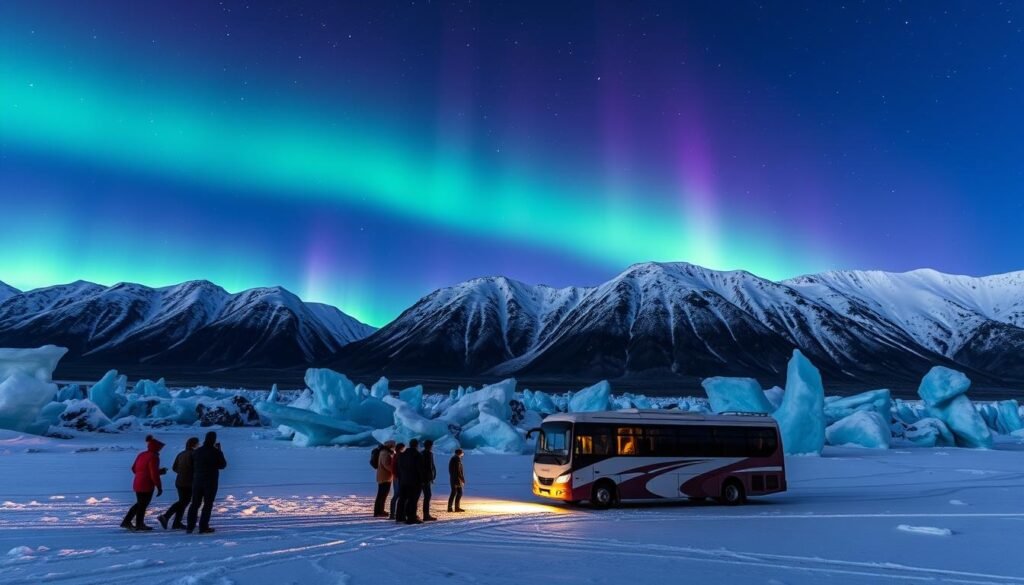
Seeing the Northern Lights in Iceland on guided tours for northern lights Iceland is special. It gives you a good chance to see this amazing natural wonder. The best time to book is from late August to late April. Tours usually last about four hours.
Guides change their plans based on aurora forecasts and weather. This makes sure you see the lights at their best.
I went on a tour with Gray Line Iceland. Our guides took us through beautiful landscapes to find the best spots for the lights. The best time to see them is from 9 PM to 2 AM, especially in December.
Tour operators give you the right gear and take you away from city lights. This makes it more comfortable and helps you see better.
- Flexible itineraries based on aurora forecasts.
- Guided experience by local experts who understand the landscape.
- Multiple tour options, ranging from budget-friendly bus tours to premium experiences.
- Gear provided for comfort and viewing efficiency.
If you don’t see the lights, some companies like Nordic Visitor give you a second chance. They might offer refunds or let you reschedule. Seeing the Northern Lights is unforgettable, with colors changing each time.
During peak times, the lights can last from a few minutes to over an hour. Taking a guided tour in Iceland is a great way to see the auroras. You’ll also enjoy the country’s beautiful landscapes.
Hunting the Northern Lights with a Rental Car in Iceland
Going on a rental car northern lights hunting trip is super flexible. I can drive around Iceland by myself. This lets me find quiet spots away from city lights.
Winter nights are dark, with less than five hours of daylight. This makes it easier to see the auroras. The best times to see them are between 9:30 PM and 1 AM. Checking the aurora forecast helps plan my trip.
Knowing where to go is key. I like places like the Snæfellsnes peninsula and Jökulsárlón glacier lagoon. With a car, I can find the best spots for clear skies or solar activity.
But, I’m careful about driving in winter. I check the weather and roads before I go. This helps me stay safe and see the auroras.
| Location | Distance from Reykjavík | Best Viewing Times |
|---|---|---|
| Snæfellsnes Peninsula | 180 km | Late September – March |
| Arctic Coast Way | 220 km | Late September – March |
| Jökulsárlón Glacier Lagoon | 380 km | Late September – March |
| Golden Circle | 80 km | Late September – March |
Driving around to see the northern lights is an adventure. It’s a mix of fun and knowing what to do. This way, I make amazing memories in Iceland’s beautiful landscapes.
What to Wear for a Northern Lights Hunt in Iceland
Going on a Northern Lights hunt in Iceland needs careful planning. This is especially true for clothing for northern lights in Iceland. The cold and changing weather demand the right clothes.
Wearing layers is key to staying warm and comfy. Start with thermal underwear to keep heat near your body. Next, add a warm layer like a wool sweater or fleece. Don’t forget a waterproof outer layer, especially near the ocean or in storms.
Here’s a detailed guide on what to wear northern lights:
| Item | Description |
|---|---|
| Thermal Underwear | Base layer to keep body heat in while wicking moisture away. |
| Insulated Layers | Wool sweaters or fleece jackets that provide warmth. |
| Waterproof Outerwear | Windproof and waterproof jacket and pants to protect against the elements. |
| Wool Socks | Thick socks that keep feet warm and dry. |
| Insulated Boots | Sturdy boots designed for cold conditions, preferably waterproof. |
| Warm Accessories | Hats, gloves, and scarves to protect extremities and maintain warmth. |
| Hand Warmers | Portable warmers for pockets and gloves to fend off the chill. |
| Heavy Coat | An all-weather coat that keeps you warm during those late-night adventures. |
Getting ready with the right clothing for northern lights in Iceland makes your trip better. Keep an eye on the weather, bring extra clothes, and remember your camera. With the right clothes, your Northern Lights adventure will be unforgettable.
Conclusion
Seeing the Northern Lights in Iceland is an amazing adventure. The colors in the sky are so vivid. This natural wonder, known as the Iceland aurora borealis, is even more special with good planning.
Travelers can see this amazing sight by watching local weather and knowing the best times. The months from September to April are the best for viewing. The dark nights make it perfect for seeing the auroras.
This guide has helped me a lot. It shows how to see the Northern Lights at their best. By picking the right spots and times, and using good camera skills, anyone can enjoy this wonder. Seeing the Northern Lights is a journey that leaves a lasting impression of Iceland’s beauty.
